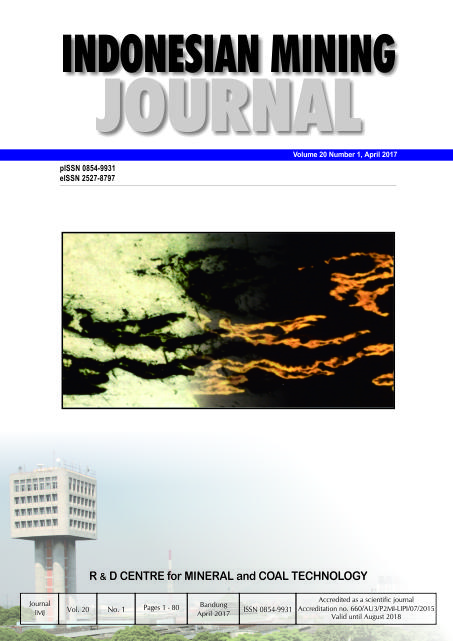MAKING OF IRON NUGGET FROM CONCENTRATED IRON SAND USING MINI-SIZED ROTARY KILN
DOI:
https://doi.org/10.30556/imj.Vol20.No1.2017.183Keywords:
iron nugget, rotary kiln, Krupp-Renn technology, concentrated iron sand, oxidation and reduction processesAbstract
The availability of energy becomes a major problem in the construction of iron mineral-based smelter to produce ferrous metals in the form of pig iron. Therefore, it is necessary to develop the Krupp-Renn technology that based on coal as a reducing agent to produce pig iron in the form of nuggets. Such a technology employs a rotary kiln that consumes less energy than other furnaces. In this study, reduction process of iron sand concentrates with coal as the reductant was accomplished in a mini-sized rotary kiln (0.6 m diameter and 6 m length). The process of iron nugget making from iron sand concentrate was conducted in two (2) stages, namely oxidation and reduction processes. The former was accomplished at a temperature above 800°C for 2 (two) hours to produce hematite phase. While the later was carried out at 1250-1300°C for 6-8 hours. Both processes produced iron nuggets that contained more than 90% Fe. The highest Fe content reached 96.49% Fe. Such a nugget could meet the requirement for steel making.References
Anameric, B. and Kawatra, S. K. (2007) “Properties and features of direct reduced iron,” Mineral Processing and Extractive Metallurgy Review, 28(1), pp. 59–116. doi: 10.1080/08827500600835576.
Anameric, B. and Kawatra, S. K. (2008) “Direct iron smelting reduction processes,” Mineral Processing and Extractive Metallurgy Review, 30(1), pp. 1–51. doi: 10.1080/08827500802043490.
Birol, B. and Saridede, M. N. (2013) “The effect of reduction parameters on iron nugget production from composite pellets,” Mineral Processing and Extractive Metallurgy Review, 34(4), pp. 195–201. doi: 10.1080/08827508.2012.695305.
Çamci, L., Aydin, S. and Arslan, C. (2002) “Reduction of iron oxides in solid wastes generated by steelworks,” Turkish Journal of Engineering and Environmental Sciences, 26(1), pp. 37–44.
Guang, W., Qing-guo, X. and Jing-song, W. (2015) “Preparation of iron nugget using low grade iron ore of high alumina and sulphur,” Iron and steel, 50(11), pp. 14–20. doi: 10.13228/10.13228/j.boyuan.issn0449-749x.20150004.
Mharakurwa, E. ., Nyakoe, G. N. and Ikua, B. W. (2014) “Accretion control in sponge iron production kiln using fuzzy logic,” Innovative Systems Design and Engineering, 5(7), pp. 41–51.
Nogucira, A., Takano, C., Mourão, M. and Pillihuaman, A. (2014) “Effects of reducer and slag concentrations in the iron-carbon nuggets coalescence in self reducing processes,” in TMS Annual Meeting, pp. 247–254. Available at: http://www.scopus.com/inward/record.url?eid=2-s2.0-84899831718&partnerID=tZOtx3y1.
Ostrovski, O., Dewan, M. A. and Zhang, G. (2007) “Synthesis of titanium oxycarbide by carbothermal reduction of titania,” in Niinomi, M. and Gakkai, N. K. (eds.) Ti-2007 Science and Technology : proceedings of the 11th World Conference on Titanium (JIMIC5). Kyoto, p. 851.
Park, J.-O. and Jung, S.-M. (2015) “Metal/Slag separation behavior of CCA with various slag systems and effect of slag composition on the content of sulfur and phosphorus in iron nugget,” ISIJ International, 55(8), pp. 1625–1632. doi: 10.2355/isijinternational.ISIJINT-2015-118.
Sah, R. and Dutta, S. K. (2010) “Effects of binder on the properties of iron ore-coal composite pellets,” Mineral Processing and Extractive Metallurgy Review, 31(2), pp. 73–85. doi: 10.1080/08827500903404732.
Singh, A. and Jain, P. (2015) “A study on the accretion formation in DRI kilns and possible ways for its reduction,” IOSR Journal of Mechanical and Civil Engineering (IOSR-JMCE), 12(6), pp. 98–103.
Tsuji, H. and Tachino, N. (2012) “Ring formation in the smelting of saprolite Ni-ore in a rotary kiln for production of ferro-nickel alloy: examination of the mechanism,” ISIJ International, 52(11), pp. 1951–1957. doi: 10.2355/isijinternational.52.1951.
Downloads
Published
Issue
Section
License
Indonesian Mining Journal provides immediate open access to its content on the principle that making research freely available to the public to supports a greater global exchange of knowledge.

This work is licensed under a Creative Commons Attribution-NonCommercial 4.0 International License.













